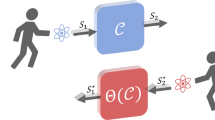Abstract
Two approaches toward the arrow of time for scattering processes have been proposed in rigged Hilbert space quantum mechanics. One, due to Arno Bohm, involves preparations and registrations in laboratory operations and results in two semigroups oriented in the forward direction of time. The other, employed by the Brussels-Austin group, is more general, involving excitations and de-excitations of systems, and apparently results in two semigroups oriented in opposite directions of time. It turns out that these two time arrows can be related to each other via Wigner's extensions of the spacetime symmetry group. Furthermore, their are subtle differences in causality as well as the possibilities for the existence and creation of time-reversed states depending on which time arrow is chosen.
Similar content being viewed by others
References
Atmanspacher, H., Bishop, R., and Amann, A. (2002). Extrinsic and intrinsic irreversibility in probabilistic dynamical laws, in Quantum Probability and White Noise Analysis, Vol. XIII, A. Khrennikov, ed., World Scientific, Singapore, 50–70.
Antoniou, I. and Prigogine, I. (1993). Physica A 192, 443–464.
Bishop, forthcoming Bishop, R. (forthcoming). Int. Journal of Theoretical Physics.
Bohm, A. (1967). Rigged Hilbert space and mathematical description of physical systems. In W. Brittin, et al. eds., Lectures in Theoretical Physics Vol IX A: Mathematical Methods of Theoretical Physics, Gordon and Breach Science Publishers, New York, pp. 255–317.
Bohm, A. (1978). The Rigged Hilbert Space and Quantum Mechanics, Springer, Berlin.
Bohm, A. (1995). Physical Review A 51, 1758–1769.
Bohm, A. and Gadella, M. (1989). Dirac Kets, Gamow Vectors, and Gel'fand Triplets, Lecture Notes in Physics, Vol. 348, Springer, Berlin.
Bohm, A., Maxson, S., Loewe, M., and Gadella, M. (1997). Physica A 236, 485–549.
Bohm, A. and Wickramasekara, S. (1997). Foundations of Physics 27, 969–993.
Cariñena, J. and Santander, M. (1981). Journal of Mathematical Physics 22, 1548.
Gel'fand, I. and Shilov, G. (1967). Generalized Functions, Vol. 3: Theory of Differential Equations, M. Mayer (trans.), Academic, New York.
Gel'fand, I. and Vilenkin, N. (1964). Generalized Functions, Vol. 4: Applications of Harmonic Analysis, A. Feinstein (trans.), Academic, New York.
George, C. (1971). Bulletin de la Classe des Sciences Academie Royale des Sciences, des Lettres et des Beaux-Arts de Belgique 56, 505
Lax, P. and Phillips, R. (1967). Scattering Theory, Academic Press, New York.
Lee, T. (1981). Particle Physics and Introduction to Field Theory, Harwood Academic Publishers, New York.
Ludwig, G. (1983). Foundations of Quantum Mechanics, Vol. I, Springer, Berlin.
Ludwig, G. (1985). Foundations of Quantum Mechanics, Vol. II, Springer, Berlin.
von Neumann, J. (1955/1932). Mathematical Foundations of Quantum Mechanics, Princeton University Press, Princeton.
Wheeler, J. and Zurek, W. (1988). Quantum Theory and Measurement, Princeton University Press, Princeton.
Wigner, E. (1964). Unitary representations of the inhomogeneous Lorentz group including reflections. In Group Theoretical Concepts and Methods in Elementary Particle Physics, F. Gürsey, ed., Gordon and Breach, Science Publishers, New York.
Zeh, H. (1999). The Physical Basis of the Direction of Time, 3rd Edn., Springer, Berlin.
Author information
Authors and Affiliations
Corresponding author
Rights and permissions
About this article
Cite this article
Bishop, R.C. Quantum Time Arrows, Semigroups and Time-Reversal in Scattering. Int J Theor Phys 44, 723–733 (2005). https://doi.org/10.1007/s10773-005-7050-2
Received:
Accepted:
Issue Date:
DOI: https://doi.org/10.1007/s10773-005-7050-2




